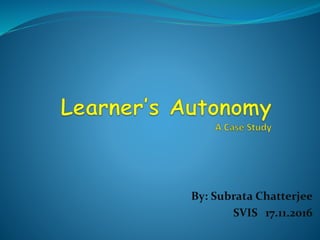Report
Share

Recommended
Recommended
More Related Content
What's hot
What's hot (20)
Oral, Written and Performance Evaluation in Education

Oral, Written and Performance Evaluation in Education
Understanding the language background of the students - Home language vs Scho...

Understanding the language background of the students - Home language vs Scho...
Viewers also liked
Viewers also liked (8)
Principles Of Being Successful- Goal Setting In Seven Steps

Principles Of Being Successful- Goal Setting In Seven Steps
Flipped Classroom - das konsequente Blended Learning

Flipped Classroom - das konsequente Blended Learning
Similar to Learner's Autonomy
Keynote Presentation by Carole McBride at the First Quality Assurance Authority for Education and Training - 9 & 10 February 2011 - BahrainQAAET Conference- Teaching & Learning - Carole McBride

QAAET Conference- Teaching & Learning - Carole McBrideQuality Assurance Authority for Education & Training QAAET
Keynote Presentation by Carole McBride at the First Quality Assurance Authority for Education and Training - 9 & 10 February 2011 - BahrainQAAET Conference- Teaching & Learning - Carole McBride

QAAET Conference- Teaching & Learning - Carole McBrideQuality Assurance Authority for Education & Training QAAET
Similar to Learner's Autonomy (20)
UNIT I_ Paradigm Shift from Pedagogy to Andragogy to Heutagogy - Concepts and...

UNIT I_ Paradigm Shift from Pedagogy to Andragogy to Heutagogy - Concepts and...
Become a leading learner. Connected learning: A Smart framework for educators

Become a leading learner. Connected learning: A Smart framework for educators
Teaching-Nature-Objective-Characteristics-Basic-Requirements-pdf.pdf

Teaching-Nature-Objective-Characteristics-Basic-Requirements-pdf.pdf
QAAET Conference- Teaching & Learning - Carole McBride

QAAET Conference- Teaching & Learning - Carole McBride
QAAET Conference- Teaching & Learning - Carole McBride

QAAET Conference- Teaching & Learning - Carole McBride
Experiential approach of learning mathematics- Thiyagu

Experiential approach of learning mathematics- Thiyagu
Learner's Autonomy
- 1. By: Subrata Chatterjee SVIS 17.11.2016
- 2. •Multifarious Behavioral Objectives (Application of Bloom’s Taxonomy) •Plurality of Learning Experiences •Activity based Learning Process •Competency Oriented Modes of Assessment •CAT (Classroom Assessment Techniques) •Learners Autonomy and CCE
- 3. •Learner’s autonomy implies learner’s growing independence and responsibility to his/her self direction in the learning process and to enable greater control of his/her learning. •“ Learner’s Autonomy is a perennial dynamic process amenable to ‘educational interventions’ rather than a static product. It is the goal of an ideal pedagogy”…….Thanasoulas (2013)
- 4. Knowledge Comprehension Application Analysis Synthesis Evaluation
- 7. Curricular Areas Physical and Health Education Art and Craft Education Work Education Human Rights and Gender Studies Financial Marketing Management Mass Media Co-Curricular Areas Personal and Social Qualities Willingness to learn Sense of responsibility Positive Attitude Values Soft Skills Interests and Beleifs
- 8. • Constructivist Instructional Approaches • Peer Tutoring • Reciprocal Teaching and Classroom Discussion • Assigning of group project • Multidisciplinary Project
- 9. Constructivism is a kind of teaching philosophy based on the concept of learning. It is a process that happens along with learning. Learning is the result of prior knowledge, so that learners can construct their own knowledge by thinking about their previous knowledge and by adding new information on it. Each learner tries to make a mental note and build their critical thinking which makes them an independent learner.
- 10. The main goal of adopting constructivist teaching is to instill in them an exploration of thinking. Some of the methods that are used are •Learning is activity based. It might be experimentation, or projects. •Whole group of learners are actively involved. •The activity sessions should be interactive. •The teacher must discuss and negotiate with the learners. •The teachers must motivate the learners and provide them with feedbacks.
- 11. Conceptualized that learning is an active process of construction rather than a passive assimilation of information or rote memorization. •Believed all learning is constructed, whether it is something we are taught or something we learn on our own. • Whether or not we are taught in a “constructivist” manner, Piaget believed we are constructing knowledge in all our learning.
- 12. According to him •Two main states – equilibrium & disequilibrium Believed that we are driven or motivated to learn when we are in disequilibrium –We want to understand things –The level of disequilibrium must be just right or optimal
- 15. As a Partner As a mediator As a Facilitator
- 16. Problem solving and competence based testing To nurture Higher Order Thinking Skills Learning without burden Periodical assessment Classroom assessment Techniques
- 18. Prior Knowledge Inventory Misconception/Preconception Check Focused Listing or Memory Matrix Minute Paper Assessing Understanding (Muddiest Point) Assessing analysis and critical thinking A proper feedback system to know about the learning
- 19. The shift of learning responsibility from teachers to learners does not exist in a vacuum, rather in certain context. Continuous and Comprehensive Evaluation is the context. It is one of the interventions to provide multifarious opportunities and to create favorable ground for nurturing and flourishing autonomy in learner.
